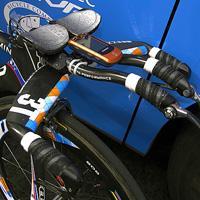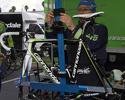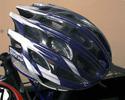
Recently on Cyclingnews.com |
Race tech: Tour of California, February 17, 2009
A possible disaster on the horizon
By James Huang in Santa Cruz, California

|
Is that 8 x 2.5cm or 3:1? Confusion surrounding obscure UCI rule has teams in panic
Team management and mechanics were awash in panic after rumours swirled that the UCI would be rigidly enforcing a new technical rule at this Friday’s time trial in Solvang - not beginning in 2010, as many had apparently assumed.
UCI technical ruling 1.3.024 - which was just modified on 1 Jan 2009 - states that, "A fuselage form shall be defined as an extension or streamlining of a section. This shall be tolerated as long as the ratio between the length (L) and the diameter (D) does not exceed 3."
Previously the rules stated only that cross-sections of any particular frame or component had to fit within an 8 x 2.5cm rectangle. By that definition, all of the equipment currently planned for use on Friday is legal. However, if the 3-to-1 rule is applied, nearly every team currently listed on the Tour of California roster is headed for disaster unless some sort of contingency plan is put into effect.
Among the equipment violations would be virtually every aero handlebar currently in use (with one notable exception being Bontrager), many aero seatposts, some wheels and possibly even some frames.
The potential penalties for violating the ruling are undoubtedly severe: either the rider would simply not be allowed to start with the equipment in question, or the rule could be retroactively applied and the applicable performance could be disqualified.
Alternate options discussed by various teams range from incredibly inconvenient to downright impossible: scores of aero handlebars would have to be both obtained and installed prior to Friday or riders would be forced to use their road bikes on the decisive stage.
On a more general note, the ruling could also threaten the very existence of a number of aero equipment manufacturers including Oval Concepts, Vision and 3T. Stay tuned for additional information.

|
New R-SYS wheels for Ag2r
Mavic has acted quickly for its sponsored teams to the unfortunate R-SYS wheel recall it announced just a few weeks ago. Ag2r riders were already equipped with updated versions prior to the start of stage two and new wheels for OUCH team members were slated to arrive at the team hotel as they arrived in Santa Cruz.
According to Mavic marketing director Sean Sullivan, changes are limited solely to the tubular carbon spokes which now use both unidirectional and multidirectional layers - the original ones were unidirectional only - plus "other enhancements" in an effort to increase impact strength and overall durability.
Visual changes are still rather subtle though, and include a slightly different surface sheen. However, Mavic has added three silver circumferential stripes to the rim end of each spoke for easier identification. Total weight is essentially unchanged.
Liquigas’ bike measuring jig

|
The 2009 Tour of California has barely gotten underway yet Ivan Basso (Liquigas) is already prepping for some testing in the San Diego Low Speed Wind Tunnel. Team mechanics were seen replicating Basso’s time trial position on a standard road frame for the purpose a day prior to the prologue but what they were using to set it up was perhaps even more interesting.
While other teams rely on felt-tipped markers, bubble levels, measuring tapes and plumb bobs, the Liquigas wrenches cracked out an impressively thorough-looking jig that provides accurate - and more importantly, repeatable - figures for critical measurements such as saddle and bar positions.
A large horizontal beam resting on dummy front and rear axles ensures a relative level while the base of a vertical beam is anchored at the bottom bracket spindle to provide a zero point for all subsequent measurements. Sliding rods up top at either end of the bike are used to gage saddle and handlebar positions and a Cartesian (i.e. x-y) coordinate system makes for easier translation of numbers.
Though the initial design and construction of the jig assuredly required a significant initial investment in both time and money, the time saved by the mechanics in using it and the presumably more reliable numbers it produces likely makes it well worth the while.
Clever helmet covers for Quick Step

|
Stage 2’s nasty conditions found some Quick Step riders donning a special team-only addition to their S-Works helmets: a snap-on clear polycarbonate cover that obscures most of the upper and forward-facing vents. First seen on the helmets of Specialized mountain bike team riders Lene Byberg and Liam Killeen during last year’s World Cup, the handy caps have apparently now found favour with their road counterparts as well.
Specialized seemingly had little intention of producing the covers for consumer use back then but seems to have softened its stance now. "They’re talking about [putting into production] but we’re not sure right now," said Specialized PR man Nic Sims.
Photography
For a thumbnail gallery of these images, click here
Images by James Huang/Cyclingnews.com
- How will this new UCI rule affect the Tour of California come Friday's time trial?
- If UCI commissaires elect to strictly enforce the new rule bars such as this one belonging to Dave Zabriskie would be ineligible to start.
- Cervélo Test Team riders such as Carlos Sastre would also be impacted.
- These radical bars belonging to Columbia-Highroad and similar ones on Rabobank's would certainly be ruled illegal if the rule was enforced.
- Astana riders can thankfully rest at ease since the Bontrager aerobar dimensions lie within the 3-to-1 aspect ratio rule.
- Bontrager may have sacrificed some aerodynamic drag in designing its bar but depending on what happens with the UCI, that extra drag will actually end up paying big dividends since the team will be able to run their usual equipment.
- And what about other parts such as aero seatposts? If the rule is rigidly interpreted, some posts would be illegal as well. This Bontrager post luckily falls within the guidelines though.
- Ambiguities in the UCI tech rule wording leave many wondering about other components such as wheels, too.
- Ag2r riders set off for stage 2 of the Tour of California with updated versions of Mavic's R-SYS wheel.
- The new spokes use both unidirectional and multidirectional carbon layers for increased impact resistance and better overall durability.
- As was the case with many riders today, Ag2r riders paired shallow-section front wheels with deeper rears.
- Liquigas mechanics were seen setting up one of Ivan Basso's road frames with his time trial position. According to team liaison Rory Mason, this was strictly for wind tunnel testing slated for after the race.
- Liquigas isn't content to simply use basic measurement tools in setting up its bikes. This custom jig provides rock-solid measurements for more reliably accurate setups.
- All measurements are referenced from the bottom bracket spindle.
- A bubble level is fitted to the horizontal crossbar but resting its ends on dummy axles front and rear already guarantees proper alignment.
- Sliding fixtures up top make for easier setup of saddles and bars.
- Basso's bars in the midst of an aero extension installation.
- In spite of Mason's plausible explanation about Basso's setup, we still can't help but wonder: if this bike was being built up purely for refining Basso's position, why go through the trouble of installing an aero outer chainring?
- Basso's bike is also fitted with a tidy-looking custom chain watcher.
- Other team bikes were also fitted with chain watchers but these aren't nearly as nice.
- Even pro riders like to keep their bikes looking good. This Liquigas mechanic is applying some protective film to Basso's crankarms.
- Quick Step riders kept their heads relatively warm and dry with the help of these team-only snap-on polycarbonate helmet covers.
- The lightweight covers obscure the upper and forward vents from cold air and water.
